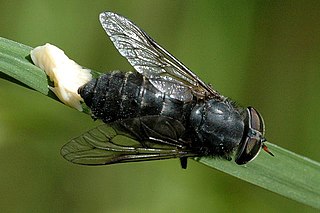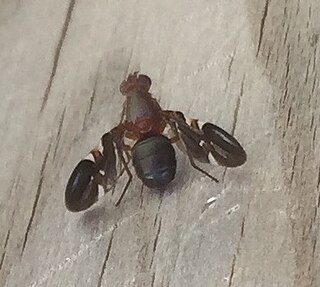
Entomology is the scientific study of insects, a branch of zoology. In the past the term insect was less specific, and historically the definition of entomology would also include the study of animals in other arthropod groups, such as arachnids, myriapods, and crustaceans. This wider meaning may still be encountered in informal use.
The Entomological Society of America (ESA) was founded in 1889 and today has more than 7,000 members, including educators, extension personnel, consultants, students, researchers, and scientists from agricultural departments, health agencies, private industries, colleges and universities, and state and federal governments. It serves the professional and scientific needs of entomologists and people in related disciplines. To facilitate communication among members, the ESA is divided into four sections based on entomological interests, and six branches, based on geographic proximity. The national office is located in Annapolis, Maryland.

James Fletcher was a Canadian entomologist, botanist, and writer.

Thaddeus William Harris was an American entomologist and librarian. His focus on insect life cycles and interactions with plants was influential in broadening American entomological studies beyond a narrow taxonomic approach. He was an early agricultural entomologist and served as a mentor and role model for others in this new field. For 25 years Harris served as the librarian of Harvard University where oversaw the rapid growth of the library and introduced one of the earliest American library card catalogs.

Leland Ossian Howard was a pioneer American entomologist who worked in the US Department of Agriculture. Serving as the chief of the bureau of entomology, a successor to C.V. Riley, he helped establish economic entomology as a profession in the United States and strengthened research activities, helping establish laws to prevent the introduction of agricultural pests. He was a specialist on the parasitic wasp family Chalcididae, and contributed to the introduction of biological control agents for pest management. Howard also took an interest in medical entomology.
Economic entomology is a field of entomology, which involves the study of insects that benefit or harm humans, domestic animals, and crops. Insects that pose disadvantages are considered pests. Some species can cause indirect damage by spreading diseases, and these are termed as disease vectors. Those that are beneficial include those that are reared for food such as honey, substances such as lac or pigments, and for their role in pollinating crops and controlling pests.

The American Elm cultivar Ulmus americana 'Jefferson' was cloned from a tree growing near a path in front of the Freer Gallery of Art, close to the Smithsonian Institution Building on the National Mall in Washington, D.C. The United States National Park Service, which had planted the tree during the 1930s, cloned it in 1993 after screening tests showed that it possessed an outstanding level of tolerance to Dutch elm disease (DED).

Agriculture in Chile encompasses a wide range of different activities due to its particular geography, climate, geology and human factors. Historically agriculture is one of the bases of Chile's economy, now agriculture and allied sectors—like forestry, logging and fishing—account only for 4.9% of the GDP as of 2007 and employed 13.6% of the country's labor force. Some major agricultural products of Chile include grapes, apples, onions, wheat, corn, oats, peaches, garlic, asparagus, beans, beef, poultry, wool, fish and timber. Due to its geographical isolation and strict customs policies, Chile is free from diseases such as Mad Cow, fruit fly and Phylloxera, this plus being located in the southern hemisphere and its wide range of agriculture conditions are considered Chile's main comparative advantages. However, the mountainous landscape of Chile limits the extent and intensity of agriculture so that arable land corresponds only to 2.62% of the total territory.

Hybomitra is a genus of horse flies in the family Tabanidae. There are at least 240 described species in Hybomitra.

The Sierolomorphidae are a family of 13 extant species of wasps, in the genera Sierolomorpha and Proscleroderma, mostly found in the Northern Hemisphere. They are rare and very little is known of their biology. A fossil species Loreisomorpha nascimbenei has also been placed in the family.

William Saunders, CMG was a Canadian agriculturalist, entomologist and pharmacist. He was a pioneer in Canadian agricultural science, led the establishment of the Experimental Farm System and served as its first director for almost 25 years.
Gnadochaeta is a genus of flies in the family Tachinidae.

James Halliday McDunnough was a Canadian linguist, musician, and entomologist best known for his work with North American Lepidoptera, but who also made important contributions about North American Ephemeroptera.

Charles Henry Fernald was an American entomologist, geologist, and zoologist, who is credited as the first college professor of economic entomology. Fernald grew up at Fernald Point in Mount Desert, Maine, and went on to prepare for college at Maine Wesleyan Seminary before joining the navy in 1862. After receiving a master's degree from Bowdoin College he went on to serve as principal of several academies in Maine. Throughout his career he would document and describe several species of microlepidoptera and in 1886 became the first full-time professor and chair of the natural sciences at what is now the University of Massachusetts Amherst. Fernald Hall and the Fernald Entomological Society at the same institution, are named for him and his son, Henry Torsey Fernald, who would later hold the same position as his father. His wife, Maria Elizabeth Fernald, was a noted entomologist in her own right.

Ernest Melville DuPorte was a Canadian entomologist best known for his research in insect morphology. He has been described as "a father of confederation for entomology" by Robin Stewart.

Charles Gordon Hewitt was a Canadian economic entomologist and pioneer of conservation biology. He was appointed dominion entomologist of Canada in 1909. He helped in the development of the Destructive Insect and Pest Act of 1910, and implemented significant changes in the Department of Agriculture. He published several books on the subjects of biology and entomology, and helped to further the 1916 treaty between Canada and the United States for the protection of migratory birds.

Delphinia picta is a species of picture-winged fly in the family Ulidiidae. The specific name picta is from Latin and means "painted." It is the only species in the monospecific genus Delphinia. It is found in the United States on the East Coast and in the Midwest from Florida to Maine across to Kansas through Minnesota but also can be found in Mexico and El Salvador. It is sometimes mistaken for a species of fruit fly, but D. picta do not feed on living plant matter, as they are detritivores and eat decaying plant matter. They also have been observed eating fermenting frass from Megacyllene robiniae on black locust trees. They can be found almost anywhere there is decaying vegetation: landfills, temperate deciduous forests, swamps, and even shaded fields.

Calycomyza is a genus of flies in the family Agromyzidae.

Agriculture in Chile has a long history dating back to the Pre-Hispanic period. Indigenous peoples practised varying types of agriculture, from the oases of the Atacama Desert to as far south as the Guaitecas Archipelago. Potato was the staple food in the populous Mapuche lands. Llama and chilihueque herding was practised by various indigenous groups.
[Chile] is rich in pastures and cultivated fields, in which all kind of animals and plants can be breed or grown, there is plenty of very beautiful wood for making houses, and plenty of firewood, and rich gold mines, and all land is full of them...
















